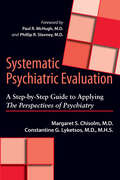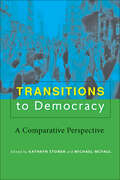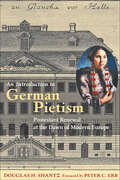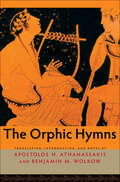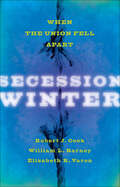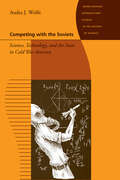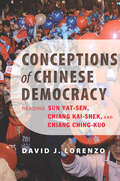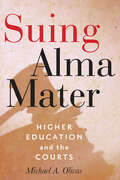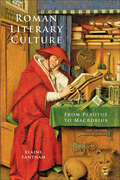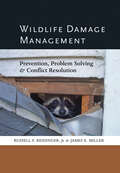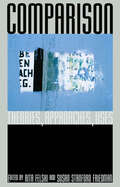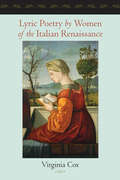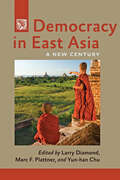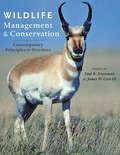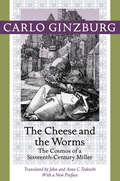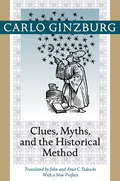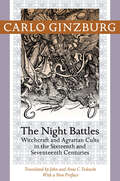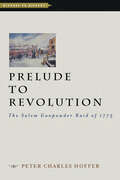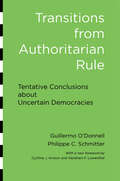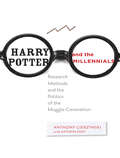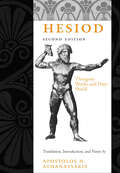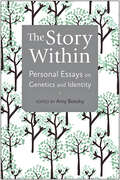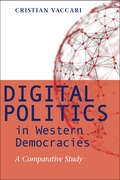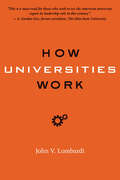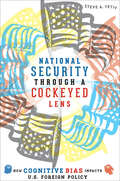- Table View
- List View
Systematic Psychiatric Evaluation: A Step-by-Step Guide to Applying The Perspectives of Psychiatry
by Margaret S. Chisolm Constantine G. LyketsosTwo Johns Hopkins psychiatrists explain the Perspectives approach to evaluating patients with psychiatric disorders.The Perspectives approach to psychiatry focuses on four aspects of psychiatric practice and research: disease, dimensional, behavior, and lifestory. In Systematic Psychiatric Evaluation, Drs. Margaret S. Chisolm and Constantine G. Lyketsos underscore the benefits of this approach, showing how it improves clinicians' abilities to evaluate, diagnose, and treat patients.Drs. Chisolm and Lyketsos use increasingly complex case histories to help the mental health provider evaluate patients demonstrating symptoms of bipolar disorder, psychosis, suicidal ideation, depression, eating disorders, and cutting, among other conditions. The book also includes an exercise that simulates the Perspectives approach side by side with traditional methods, revealing the advantages of a method that engages not one but four points of view. Featuring a foreword by Drs. Paul R. McHugh and Phillip R. Slavney, the originators of the Perspectives approach, this innovative book will be used in psychiatric training programs as well as by practicing mental health clinicians.
Transitions to Democracy: A Comparative Perspective
by Kathryn Stoner and Michael McFaulFifteen case studies by scholars and practitioners demonstrate the synergy between domestic and international influences that can precipitate democratic transitions.As demonstrated by current events in Tunisia and Egypt, oppressive regimes are rarely immune to their citizens’ desire for democratic government. Of course, desire is always tempered by reality; therefore how democratic demands are made manifest is a critical source of study for both political scientists and foreign policy makers. What issues and consequences surround the fall of a government, what type of regime replaces it, and to what extent are these efforts successful? Kathryn Stoner and Michael McFaul have created an accessible book of fifteen case studies from around the world that will help students understand these complex issues. Their model builds upon Guillermo O’Donnell, Philippe C. Schmitter, and Laurence Whitehead's classic work, Transitions from Authoritarian Rule, using a rubric of four identifying factors that can be applied to each case study, making comparison relatively easy. Transitions to Democracy yields strong comparisons and insights. For instance, the study reveals that efforts led by the elite and involving the military are generally unsuccessful, whereas mass mobilization, civic groups, and new media have become significant factors in supporting and sustaining democratic actors. This collection of writings by scholars and practitioners is organized into three parts: successful transitions, incremental transitions, and failed transitions. Extensive primary research and a rubric that can be applied to burgeoning democracies offer readers valuable tools and information.
An Introduction to German Pietism: Protestant Renewal at the Dawn of Modern Europe (Young Center Books in Anabaptist and Pietist Studies)
by Douglas H. ShantzAn up-to-date portrait of a defining moment in the Christian story—its beginnings, worldview, and cultural significance.Winner of the Dale W. Brown Book Award of the Young Center for Anabaptists and Pietist Studies at Elizabethtown CollegeAn Introduction to German Pietism provides a scholarly investigation of a movement that changed the history of Protestantism. The Pietists can be credited with inspiring both Evangelicalism and modern individualism.Taking into account new discoveries in the field, Douglas H. Shantz focuses on features of Pietism that made it religiously and culturally significant. He discusses the social and religious roots of Pietism in earlier German Radicalism and situates Pietist beginnings in three cities: Frankfurt, Leipzig, and Halle. Shantz also examines the cultural worlds of the Pietists, including Pietism and gender, Pietists as readers and translators of the Bible, and Pietists as missionaries to the far reaches of the world. He not only considers Pietism's role in shaping modern western religion and culture but also reflects on the relevance of the Pietist religious paradigm of today.The first survey of German Pietism in English in forty years, An Introduction to German Pietism provides a narrative interpretation of the movement as a whole. The book's accessible tone and concise portrayal of an extensive and complex subject make it ideal for courses on early modern Christianity and German history. The book includes appendices with translations of German primary sources and discussion questions.
The Orphic Hymns
by Apostolos N. Athanassakis and Benjamin M. WolkowThe best-selling English translation of the mysterious and cosmic Greek poetry known as the Orphic Hymns.At the very beginnings of the Archaic Age, the great singer Orpheus taught a new religion that centered around the immortality of the human soul and its journey after death. He felt that achieving purity by avoiding meat and refraining from committing harm further promoted the pursuit of a peaceful life. Elements of the worship of Dionysus, such as shape-shifting and ritualistic ecstasy, were fused with Orphic beliefs to produce a powerful and illuminating new religion that found expression in the mystery cults. Practitioners of this new religion composed a great body of poetry, much of which is translated in The Orphic Hymns.The hymns presented in this book were anonymously composed somewhere in Asia Minor, most likely in the middle of the third century AD. At this turbulent time, the Hellenic past was fighting for its survival, while the new Christian faith was spreading everywhere. The Orphic Hymns thus reflect a pious spirituality in the form of traditional literary conventions. The hymns themselves are devoted to specific divinities as well as to cosmic elements. Prefaced with offerings, strings of epithets invoke the various attributes of the divinity and prayers ask for peace and health to the initiate. Apostolos N. Athanassakis and Benjamin M. Wolkow have produced an accurate and elegant translation accompanied by rich commentary.
Secession Winter: When the Union Fell Apart (The Marcus Cunliffe Lecture Series)
by Robert J. Cook William L. Barney Elizabeth R. VaronWhat prompted southern secession in the winter of 1860–61 and why did secession culminate in the American Civil War?Politicians and opinion leaders on both sides of the Mason-Dixon line struggled to formulate coherent responses to the secession of the deep South states. The Confederate attack on Fort Sumter in mid-April 1861 triggered civil war and the loss of four upper South states from the Union. The essays by three senior historians in Secession Winter explore the robust debates that preceded these events.For five months in the winter of 1860–1861, Americans did not know for certain that civil war was upon them. Some hoped for a compromise; others wanted a fight. Many struggled to understand what was happening to their country. Robert J. Cook, William L. Barney, and Elizabeth R. Varon take approaches to this period that combine political, economic, and social-cultural lines of analysis. Rather than focus on whether civil war was inevitable, they look at the political process of secession and find multiple internal divisions—political parties, whites and nonwhites, elites and masses, men and women. Even individual northerners and southerners suffered inner conflicts. The authors include the voices of Unionists and Whig party moderates who had much to lose and upcountry folk who owned no slaves and did not particularly like those who did. Barney contends that white southerners were driven to secede by anxiety and guilt over slavery. Varon takes a new look at Robert E. Lee's decision to join the Confederacy. Cook argues that both northern and southern politicians claimed the rightness of their cause by constructing selective narratives of historical grievances. Secession Winter explores the fact of contingency and reminds readers and students that nothing was foreordained.
Competing with the Soviets: Science, Technology, and the State in Cold War America (Johns Hopkins Introductory Studies in the History of Science)
by Audra J. WolfeA synthetic account of how science became a central weapon in the ideological Cold War.Honorable Mention for the Forum for the History of Science in America Book Prize of the Forum for the History of Science in AmericaFor most of the second half of the twentieth century, the United States and its allies competed with a hostile Soviet Union in almost every way imaginable except open military engagement. The Cold War placed two opposite conceptions of the good society before the uncommitted world and history itself, and science figured prominently in the picture. Competing with the Soviets offers a short, accessible introduction to the special role that science and technology played in maintaining state power during the Cold War, from the atomic bomb to the Human Genome Project.The high-tech machinery of nuclear physics and the space race are at the center of this story, but Audra J. Wolfe also examines the surrogate battlefield of scientific achievement in such diverse fields as urban planning, biology, and economics; explains how defense-driven federal investments created vast laboratories and research programs; and shows how unfamiliar worries about national security and corrosive questions of loyalty crept into the supposedly objective scholarly enterprise.Based on the assumption that scientists are participants in the culture in which they live, Competing with the Soviets looks beyond the debate about whether military influence distorted science in the Cold War. Scientists’ choices and opportunities have always been shaped by the ideological assumptions, political mandates, and social mores of their times. The idea that American science ever operated in a free zone outside of politics is, Wolfe argues, itself a legacy of the ideological Cold War that held up American science, and scientists, as beacons of freedom in contrast to their peers in the Soviet Union. Arranged chronologically and thematically, the book highlights how ideas about the appropriate relationships among science, scientists, and the state changed over time.
Conceptions of Chinese Democracy: Reading Sun Yat-sen, Chiang Kai-shek, and Chiang Ching-kuo
by David J. LorenzoClose attention to the writings of the founding fathers of the Republic of China on Taiwan shows that democracy is indeed compatible with Chinese culture.Conceptions of Chinese Democracy provides a coherent and critical introduction to the democratic thought of three fathers of modern Taiwan—Sun Yat-sen, Chiang Kai-shek, and Chiang Ching-kuo—in a way that is accessible and grounded in broader traditions of political theory.David J. Lorenzo’s comparative study allows the reader to understand the leaders’ democratic conceptions and highlights important contradictions, strengths, and weaknesses that are central to any discussion of Chinese culture and democratic theory. Lorenzo further considers the influence of their writings on political theorists, democracy advocates, and activists on mainland China.Students of political science and theory, democratization, and Chinese culture and history will benefit from the book's substantive discussions of democracy, and scholars and specialists will appreciate the larger arguments about the influence of these ideas and their transmission through time.
Suing Alma Mater: Higher Education and the Courts
by Michael A. OlivasThis careful reading of six legal cases in American higher education is an essential primer for understanding contemporary litigation.Winner of the Steven S. Goldberg Award for Distinguished Scholarship in Education Law of the Education Law AssociationAlthough much has been written about U.S. Supreme Court decisions involving higher education, little has been said about the foundational case law and litigation patterns emerging from the lower courts. As universities become increasingly legislated, regulated, and litigious, campuses have become testing grounds for a host of constitutional challenges. From faculty and student free speech to race- or religion-based admissions policies, Suing Alma Mater describes the key issues at play in higher education law.Eminent legal scholar Michael A. Olivas considers higher education litigation in the latter half of the twentieth century and the rise of "purposive organizations," like the American Civil Liberties Union and the Alliance Defense Fund (now known as the Alliance Defending Freedom), that exist to advance litigation. He reviews more than 120 college cases brought before the Supreme Court in the past fifty years and then discusses six key cases in depth. Suing Alma Mater provides a clear-eyed perspective on the legal issues facing higher education today.
Roman Literary Culture: From Plautus to Macrobius (Ancient Society and History)
by Elaine FanthamThis new edition broadens the scope of Fantham’s study of literary production and its reception in Rome.Scholars of ancient literature have often focused on the works and lives of major authors rather than on such questions as how these works were produced and who read them. In Roman Literary Culture, Elaine Fantham fills that void by examining the changing social and historical context of literary production in ancient Rome and its empire. Fantham’s first edition discussed the habits of Roman readers and developments in their means of access to literature, from booksellers and copyists to pirated publications and libraries. She examines the issues of patronage and the utility of literature and shows how the constraints of the physical object itself—the ancient "book"—influenced the practice of both reading and writing. She also explores the ways in which ancient criticism and critical attitudes reflected cultural assumptions of the time.In this second edition, Fantham expands the scope of her study. In the new first chapter, she examines the beginning of Roman literature—more than a century before the critical studies of Cicero and Varro. She discusses broader entertainment culture, which consisted of live performances of comedy and tragedy as well as oral presentations of the epic. A new final chapter looks at Pagan and Christian literature from the third to fifth centuries, showing how this period in Roman literature reflected its foundations in the literary culture of the late republic and Augustan age. This edition also includes a new preface and an updated bibliography.
Wildlife Damage Management: Prevention, Problem Solving, and Conflict Resolution
by Russell F. Reidinger Jr. James E. MillerA complete guide to preventing and resolving problems associated with wildlife-human interactions.Whether you are a student in a wildlife degree program or a professional wildlife biologist, you will find all the up-to-date information on wildlife damage in the pages of this clear, comprehensive text. Wildlife Damage Management covers every imaginable topic including:• pertinent biological and ecological concepts• individual-, population-, and ecosystem-level effects• survey techniques• management methods• human dimensions• economic issues• legal and political aspects• damage management strategiesAuthors Russell F. Reidinger, Jr., and James E. Miller explain the evolution of wildlife damage management, differentiate facts from myths, and detail the principles and techniques a professional biologist needs to know. The book discusses native as well as exotic invasive species, zoonotic diseases, hazards to endangered or threatened fauna and flora, and damage to crops, livestock, and property. Reidinger and Miller argue that, in recent years, the rate of undesirable human-wildlife interactions has risen in many areas, owing in part to the expansion of residences into places formerly wild or agricultural, making wildlife damage management even more relevant.From suburban deer eating gardens and shrubs, to mountain lions threatening pets and people, to accidentally introduced species outcompeting native species, Reidinger and Miller show how proper management can reduce wildlife damage to an acceptable, cost-effective level. An extensive section on available resources, a glossary that explains terms and concepts, and detailed figures will aid both students and seasoned professionals. Instructors will find this text arranged perfectly for a semester-long course. The end-of-chapter questions will allow students to ponder the ways wildlife damage management concepts can be put into practice. For those already working in the field—biologists and managers with federal, state, or international agencies—Wildlife Damage Management will serve as an ideal reference book. Destined to set the tone of wildlife damage conversations for the next decade and beyond, Reidinger and Miller belongs on the shelf of all wildlife professionals.
Comparison: Theories, Approaches, Uses
by Rita Felski & Susan Stanford FriedmanAn extended volume of New Literary History that considers the practice of comparison in literary studies and other disciplines within the humanities.Writing and teaching across cultures and disciplines makes the act of comparison inevitable. Comparative theory and methods of comparative literature and cultural anthropology have permeated the humanities as they engage more centrally with the cultural flows and circulation of past and present globalization. How do scholars make ethically and politically responsible comparisons without assuming that their own values and norms are the standard by which other cultures should be measured? Comparison expands upon a special issue of the journal New Literary History, which analyzed theories and methodologies of comparison. Six new essays from senior scholars of transnational and postcolonial studies complement the original ten pieces. The work of Gayatri Chakravorty Spivak, Ella Shohat, Robert Stam, R. Radhakrishnan, Bruce Robbins, Ania Loomba, Haun Saussy, Linda Gordon, Walter D. Mignolo, Shu-mei Shih, and Pheng Cheah are included with contributions by anthropologists Caroline B. Brettell and Richard Handler. Historical periods discussed range from the early modern to the contemporary and geographical regions that encompass the globe. Ultimately, Comparison argues for the importance of greater self-reflexivity about the politics and methods of comparison in teaching and in research.
Lyric Poetry by Women of the Italian Renaissance
by Virginia CoxBilingual, annotated edition of more than 200 poems by Italian Renaissance women, many of which have never before been published in English.Outstanding Academic Title, ChoiceLyric Poetry by Women of the Italian Renaissance is the first modern anthology of verse by Italian women of this period to give a full representation of the richness and diversity of their output. Although familiar authors such as Vittoria Colonna, Gaspara Stampa, and Veronica Gambara are well represented, half of the fifty-four poets featured are unknown even to many specialists. Especially noteworthy is an extensive selection of verse from the period following 1560, which has received little or no critical attention. This later, strikingly experimental, proto-Baroque tradition of verse is reconstructed here for the first time.Virginia Cox creates both a scholarly teaching resource and a collection of poetry accessible to general readers with no previous knowledge of the Italian poetic tradition. Each poem is presented in its original language, accompanied by a translation and commentary. An introduction traces the history of Italian lyric poetry from the fifteenth to the seventeenth century. Cox also provides a guide to meter, rhythm, and rhyme, as well as a glossary of rhetorical terms and a biographical dictionary of authors.Organized thematically, this book offers poems about love, religion, and politics; verse addressed to patrons, friends, family, and places; and polemical and correspondence verse. Four languages are represented: Greek, Latin, literary Tuscan of various levels of standardization, and the stylized rustic dialect of pavan. The volume contains more than 200 poems, of which about a quarter have never before been published in a modern edition and more than a third have not previously been available in English translation."Exhaustive and insightful... This is an amazing book, a major achievement in the field of women's studies."—Renaissance Quarterly, reviewing Women’s Writing in Italy, 1400–1650
Democracy in East Asia: A New Century (A Journal of Democracy Book)
by Larry DiamondDemocratization scholars believe that the next regional wave of transitions to democracy may unfold in East and Southeast Asia.In their introduction to the 1998 edition of Democracy in East Asia, Larry Diamond and Marc F. Plattner predicted that East Asia, with its remarkable diversity of political regimes, economies, and religions, would likely be the most critical arena in the global struggle for democracy, a prediction that has proven prescient. Although the recent political upheavals in the Middle East have understandably grabbed the world’s attention, there is reason to doubt whether the overthrow of some authoritarian regimes there will lead to the establishment of stable democracies any time soon. On the other hand, East Asia, the world’s most populous and economically dynamic region, already boasts several consolidated democracies and provides a fascinating laboratory for studies of both authoritarian resilience and the prospects for democratization. This updated volume, which features contributions by distinguished scholars in East Asian studies, will be welcomed by instructors and students in the field, particularly as U.S. foreign policy is in the process of undertaking a "pivot" toward Asia.Democracy in East Asia offers a comprehensive treatment of the political landscape in both Northeast and Southeast Asia, including discussions of China, Japan, South Korea, Taiwan, Indonesia, the Philippines, Malaysia, Singapore, Thailand, Cambodia, Laos, Vietnam, and Burma (Myanmar). Contributors: Larry Diamond, Marc F. Plattner, Francis Fukuyama, Minxin Pei, Yun-han Chu, Hyug Baeg Im, Thitinan Pongsudhirak, Dan Slater, Martin Gainsborough, Don Emmerson, Edward Aspinall, Mark Thompson, Benjamin Reilly, Joseph Wong, Chong-Min Park, Yu-tzung Chang
Wildlife Management and Conservation: Contemporary Principles and Practices (Wildlife Management And Conservation Ser.)
by Paul R. Krausman James W. Cain IIIA definitive textbook for students of wildlife management.Wildlife Management and Conservation presents a clear overview of the management and conservation of animals, their habitats, and how people influence both. The relationship among these three components of wildlife management is explained in chapters written by leading experts and is designed to prepare wildlife students for careers in which they will be charged with maintaining healthy animal populations; finding ways to restore depleted populations while reducing overabundant, introduced, or pest species; and managing relationships among various human stakeholders.Topics covered in this book include• The definitions of wildlife and management• Human dimensions of wildlife management• Animal behavior• Predator–prey relationships • Structured decision making• Issues of scale in wildlife management• Wildlife health• Historical context of wildlife management and conservation• Hunting and trapping• Nongame species• Nutrition ecology• Water management• Climate change• Conservation planning
The Cheese and the Worms: The Cosmos of a Sixteenth-Century Miller
by Carlo GinzburgThe now-classic tale of a sixteenth-century miller facing the Roman Inquisition.The Cheese and the Worms is an incisive study of popular culture in the sixteenth century as seen through the eyes of one man, the miller known as Menocchio, who was accused of heresy during the Inquisition and sentenced to death. Carlo Ginzburg uses the trial records to illustrate the religious and social conflicts of the society Menocchio lived in. For a common miller, Menocchio was surprisingly literate. In his trial testimony he made references to more than a dozen books, including the Bible, Boccaccio's Decameron, Mandeville's Travels, and a "mysterious" book that may have been the Koran. And what he read he recast in terms familiar to him, as in his own version of the creation: "All was chaos, that is earth, air, water, and fire were mixed together; and of that bulk a mass formed—just as cheese is made out of milk—and worms appeared in it, and these were the angels."Ginzburg’s influential book has been widely regarded as an early example of the analytic, case-oriented approach known as microhistory. In a thoughtful new preface, Ginzburg offers his own corollary to Menocchio’s story as he considers the discrepancy between the intentions of the writer and what gets written. The Italian miller’s story and Ginzburg’s work continue to resonate with modern readers because they focus on how oral and written culture are inextricably linked. Menocchio’s 500-year-old challenge to authority remains evocative and vital today.
Clues, Myths, and the Historical Method
by Carlo GinzburgCarlo Ginzburg considers how we assign historical context to events.More than twenty years after Clues, Myths, and the Historical Method was first published in English, this extraordinary collection remains a classic. The book brings together essays about Renaissance witchcraft, National Socialism, sixteenth-century Italian painting, Freud’s wolf-man, and other topics. In the influential centerpiece of the volume Carlo Ginzburg places historical knowledge in a long tradition of cognitive practices and shows how a research strategy based on reading clues and traces embedded in the historical record reveals otherwise hidden information. Acknowledging his debt to art history, psychoanalysis, comparative religion, and anthropology, Ginzburg challenges us to retrieve cultural and social dimensions beyond disciplinary boundaries.In his new preface, Ginzburg reflects on how easily we miss the context in which we read, write, and live. Only hindsight allows some understanding. He examines his own path in research during the 1970s and its relationship to the times, especially the political scenes of Italy and Germany. Was he influenced by the environment, he asks himself, and if so, how? Ginzburg uses his own experience to examine the elusive and constantly evolving nature of history and historical research.
The Night Battles: Witchcraft and Agrarian Cults in the Sixteenth and Seventeenth Centuries (Routledge Library Editions: Witchcraft Ser.)
by Carlo GinzburgA remarkable tale of witchcraft, folk culture, and persuasion in early modern Europe.Based on research in the Inquisitorial archives of Northern Italy, The Night Battles recounts the story of a peasant fertility cult centered on the benandanti, literally, "good walkers." These men and women described fighting extraordinary ritual battles against witches and wizards in order to protect their harvests. While their bodies slept, the souls of the benandanti were able to fly into the night sky to engage in epic spiritual combat for the good of the village. Carlo Ginzburg looks at how the Inquisition's officers interpreted these tales to support their world view that the peasants were in fact practicing sorcery. The result of this cultural clash, which lasted for more than a century, was the slow metamorphosis of the benandanti into the Inquisition's mortal enemies—witches.Relying upon this exceptionally well-documented case study, Ginzburg argues that a similar transformation of attitudes—perceiving folk beliefs as diabolical witchcraft—took place all over Europe and spread to the New World. In his new preface, Ginzburg reflects on the interplay of chance and discovery, as well as on the relationship between anomalous cases and historical generalizations.
Prelude to Revolution: The Salem Gunpowder Raid of 1775 (Witness to History)
by Peter Charles HofferPrelude to Revolution tells the story of a critical event in America’s early history, when a new nation’s fate was still uncertain.Before colonial Americans could declare independence, they had to undergo a change of heart. Beyond a desire to rebel against British mercantile and fiscal policies, they had to believe that they could stand up to the fully armed British soldier. Prelude to Revolution uncovers one story of how the Americans found that confidence.On April 19, 1775, British raids on Lexington Green and Concord Bridge made history, but it was an episode nearly two months earlier in Salem, Massachusetts, that set the stage for the hostilities. Peter Charles Hoffer has discovered records and newspaper accounts of a British gunpowder raid on Salem. Seeking powder and cannon hidden in the town, a regiment of British Regulars were foiled by quick-witted patriots who carried off the ordnance and then openly taunted the Regulars. The prudence of British commanding officer Alexander Leslie and the persistence of the patriot leaders turned a standoff into a bloodless triumph for the colonists. What might have been a violent confrontation turned into a local victory, and the patriots gloated as news spread of "Leslie’s Retreat."When British troops marched on Lexington and Concord on that pivotal day in April, Hoffer explains, each side had drawn diametrically opposed lessons from the Salem raid. It emboldened the rebels to stand fast and infuriated the British, who vowed never again to back down. After relating these battles in vivid detail, Hoffer provides a teachable problem in historic memory by asking why we celebrate Lexington and Concord but not Salem and why New Englanders recalled the events at Salem but then forgot their significance.Praise for the work of Peter Charles Hoffer"This book more than succeeds in achieving its goal of helping students understand and appreciate the cultural and intellectual environment of the Anglophone world."—New England Quarterly, reviewing When Benjamin Franklin Met the Reverend Whitefield"A synthetic essay of considerable grace and scope... An excellent overview of the field."—Journal of Legal History, reviewing Law and People in Colonial America
Transitions from Authoritarian Rule: Tentative Conclusions about Uncertain Democracies
by Guillermo O’Donnell Philippe C. Schmitter Laurence WhiteheadThe foundational text for democratization studies for over 25 years.Political science scholars consider the four-volume work Transitions from Authoritarian Rule to be a foundational text for studying the process of democratization, specifically in those cases where an authoritarian regime is giving way to some form of democratic government. The most important of the four books is without a doubt the fourth volume, Tentative Conclusions about Uncertain Democracies, also known as "the little green book."Transitions from Authoritarian Rule was the first book in any language to systematically compare the process of transition from authoritarianism across a broad range of countries. Political democracy is not the only possible outcome. Guillermo O’Donnell, Philippe C. Schmitter, and Laurence Whitehead emphasize that it's not the revolution but the transition that is critical to the growth of a democratic state. This ground-breaking insight remains highly relevant as the ramifications of the Arab Spring continue to play out.This reissue features a new foreword by Cynthia J. Arnson, director of the Latin American Program at the Woodow Wilson International Center for Scholars, and Abraham F. Lowenthal, founding director of the Latin American Program, who wrote the original volume's foreword.
Harry Potter and the Millennials: Research Methods and the Politics of the Muggle Generation
by Anthony GierzynskiA national survey of college students reveals connections between political opinion and popular culture.Without a doubt the Harry Potter series has had a powerful effect on the Millennial Generation. Millions of children grew up immersed in the world of the boy wizard—reading the books, dressing up in costume to attend midnight book release parties, watching the movies, and even creating and competing in Quidditch tournaments. Beyond what we know of the popularity of the series, however, nothing has been published on the question of the Harry Potter effect on the politics of its young readers—now voting adults. Looking to engage his students in exploring the connections between political opinion and popular culture, Anthony Gierzynski conducted a national survey of more than 1,100 college students and examined these connections as well as Millennial politics. Harry Potter and the Millennials tells the fascinating story of how the team designed the study and gathered results, explains what conclusions can and cannot be drawn, and reveals the challenges social scientists face in studying political science, sociology, and mass communication. Specifically, the evidence indicates that Harry Potter fans are more open to diversity and are more politically tolerant than nonfans; fans are also less authoritarian, less likely to support the use of deadly force or torture, more politically active, and more likely to have had a negative view of the Bush administration. Furthermore, these differences do not disappear when controlling for other important predictors of these perspectives, lending support to the argument that the series indeed had an independent effect on its audience. In this clear and cogent account, Gierzynski demonstrates how social scientists develop and design research questions and studies. An appendix of questions and resulting data, including graphs and diagrams, will appeal especially to instructors seeking to explain the nuances of political socialization. Gierzynski’s captivating analysis of media’s impact on political views, combined with the enjoyable Potter story details, makes for an irresistible project that social scientists can use to work a little magic in their classrooms.
Hesiod: Theogony, Works and Days, Shield
by HesiodHesiod belongs to the transitional period in Greek civilization between the oral tradition and the introduction of a written alphabet. His two major surviving works, the Theogony and the Works and Days, address the divine and the mundane, respectively. The Theogony traces the origins of the Greek gods and recounts the events surrounding the crowning of Zeus as their king. A manual of moral instruction in verse, the Works and Days was addressed to farmers and peasants.Introducing his celebrated translations of these two poems and of the Shield, a very ancient poem of disputed authorship, Apostolos Athanassakis positions Hesiod simultaneously as a philosopher-poet, a bard with deep roots in the culture of his native Boeotia, and the heir to a long tradition of Hellenic poetry. For this eagerly anticipated revised edition, Athanassakis has provided an expanded introduction on Hesiod and his work, subtly amended his faithful translations, significantly augmented the notes and index, and updated the bibliography. Already a classic, Hesiod: Theogony, Works and Days, Shield is now more valuable than ever for students of Greek mythology and literature.
The Story Within: Personal Essays on Genetics and Identity
by Amy BoeskyA thought-provoking collection of personal essays explores complex issues surrounding genetic identity.The contributors to The Story Within share powerful experiences of living with genetic disorders. Their stories illustrate the complexities involved in making decisions about genetic diseases: whether to be tested, who to tell, whether to have children, and whether and how to treat children medically, if treatment is available. More broadly, they consider how genetic information shapes the ways we see ourselves, the world, and our actions within it. People affected by genetic disease respond to such choices in varied and personal ways. These writers reflect that breadth of response, yet they share the desire to challenge a restricted sense of what "health" is or whose life has value. They write hoping to expand conversations about genetics and identity—to deepen debate and generate questions. They or their families are affected by Huntington’s disease, Alzheimer’s disease, cancer, genetic deafness or blindness, schizophrenia, cystic fibrosis, Tay-Sachs, hypertrophic cardiomyopathy, fragile X, or Fanconi anemia. All of their stories remind us that genetic health is complicated, dynamic, and above all, deeply personal.ContributorsMisha Angrist, Amy Boesky, Kelly Cupo, Michael Downing, Clare Dunsford, Mara Faulkner, Christine Kehl O’Hagan, Charlie Pierce, Kate Preskenis, Emily Rapp, Jennifer Rosner, Joanna Rudnick, Anabel Stenzel (deceased), Isabel Stenzel Byrnes, Laurie Strongin, Patrick Tracey, Alice Wexler
Digital Politics in Western Democracies: A Comparative Study
by Cristian VaccariA comparative analysis of political websites and their users from seven Western democracies.Digital politics is shorthand for how internet technologies have fueled the complex interactions between political actors and their constituents. Cristian Vaccari analyzes the presentation and consumption of online politics in seven advanced Western democracies—Australia, France, Germany, Italy, Spain, the United Kingdom, and the United States—from 2006 to 2010. His study not only refutes claims that the web creates homogenized American-style politics and political interaction but also empirically reveals how a nation’s unique constraints and opportunities create digital responses. Digital Politics in Western Democracies is the first large-scale comparative treatment of both the supply and the demand sides of digital politics among different countries and national political actors. It is divided into four parts: theoretical challenges and research methodology; how parties and candidates structure their websites (supply); how citizens use the websites to access campaign information (demand); and how the research results tie back to inequalities, engagement, and competition in digital politics. Because a key aspect of any political system is how its actors and citizens communicate, this book will be invaluable for scholars, students, and practitioners interested in political communication, party competition, party organization, and the study of the contemporary media landscape writ large.
How Universities Work (Higher Ed Leadership Essentials)
by John V. LombardiThe single best description of the inside workings of contemporary universities.Witty and insightful, How Universities Work is destined to be an essential handbook for anyone wanting to understand universities in the United States. John V. Lombardi gives readers an insider’s view of the academy, describing the structure, logic, dynamics, and operational styles of both public and private institutions of higher education. Lombardi defines and describes all the bits and pieces that compose a university with remarkable economy—from budgeting systems to tenure, from the library to the athletic field. Although focused on research universities, much of the discussion applies to other types of post-secondary institutions. Ideal for students, this book will form a solid foundation for courses in higher education, but it will also be a welcome addition to faculty and administrators’ personal libraries.
National Security through a Cockeyed Lens: How Cognitive Bias Impacts U.S. Foreign Policy
by Steve A. YetivHow poor decision making hurts U.S. national security."How do mental errors or cognitive biases undermine good decision making?" This is the question Steve A. Yetiv takes up in his latest foreign policy study, National Security through a Cockeyed Lens.Yetiv draws on four decades of psychological, historical, and political science research on cognitive biases to illuminate some of the key pitfalls in our leaders’ decision-making processes and some of the mental errors we make in perceiving ourselves and the world.Tracing five U.S. national security episodes—the 1979 Soviet invasion and occupation of Afghanistan; the Iran-Contra affair during the Reagan administration; the rise of al-Qaeda, leading to the 9/11 attacks; the 2003 U.S. invasion of Iraq; and the development of U.S. energy policy—Yetiv reveals how a dozen cognitive biases have been more influential in impacting U.S. national security than commonly believed or understood. Identifying a primary bias in each episode—disconnect of perception versus reality, tunnel vision ("focus feature"), distorted perception ("cockeyed lens"), overconfidence, and short-term thinking—Yetiv explains how each bias drove the decision-making process and what the outcomes were for the various actors. His concluding chapter examines a range of debiasing techniques, exploring how they can improve decision making.
